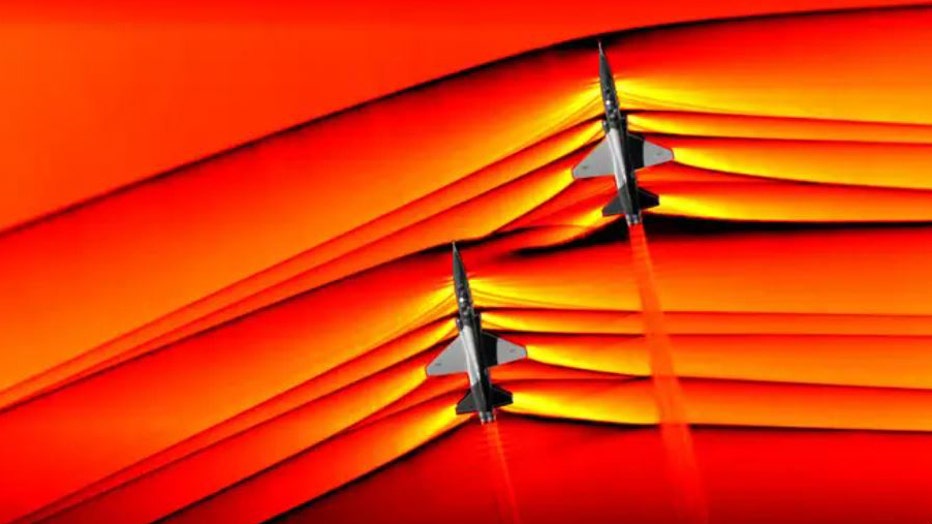NASA to reveal super quiet X-59 supersonic jet
An artist rendering of the X-59 aircraft. (NASA)
PALMDALE, Calif. - NASA plans to unveil the X-59 aircraft designed and built by Lockheed Martin to produce quiet supersonic air travel and eventually make supersonic flights available commercially.
In 2019, Lockheed Martin's Skunk Works facility was selected by NASA to design, build and test the X-59 as part of NASA's Quiet SuperSonic Technology (Quesst) mission to quiet the sonic boom. After four years of development and testing, Skunk Works is nearing the aircraft's first rollout and test flight.
NASA and Lockheed Martin officials will unveil the experimental X-59 aircraft to the public for the first time on Friday at Skunk Works in Palmdale, California. The big reveal will air live at 4 p.m. EST on NASA TV, online and on NASA+.

Using the schlieren photography technique, NASA was able to capture the first air-to-air images of the interaction of shockwaves from two supersonic aircraft flying in formation during the fourth phase of Air-to-Air Background Oriented Schlieren flig
The quiet supersonic aircraft was recently painted as part of the design process. Friday will be the first time those outside the project see the specialty paint job.
"We are incredibly excited to reach this step in the mission," said Cathy Bahm, NASA's low-boom flight demonstration project manager. "When the X-59 emerges from the paint barn with fresh paint and livery, I expect the moment to take my breath away because I’ll see our vision coming to life. The year ahead will be a big one for the X-59, and it will be thrilling for the outside of the aircraft to finally match the spectacular mission ahead."
NASA said the aircraft is painted primarily white with "sonic blue" undersides and red accents on the wings. The agency said the colors were chosen to protect the aircraft from corrosion and include key safety markings to help ground and flight operations.
NASA DELAYS ARTEMIS ASTRONAUT LAUNCHES TO THE MOON
According to Lockheed Martin, the X-59 cruises at 50,000 feet and reaches speeds up to 925 mph or Mach 1.4. However, unlike other supersonic flights, the aircraft only creates a sound about as loud as a car door closing from 20 feet away. NASA describes it as a "gentle sonic thump."
A sonic boom sound is created when shock waves from an aircraft traveling faster than the speed of sound merge together before reaching the ground.
The X-59 is almost 100 feet long, with a nose longer than a school bus. The long, skinny nose of the aircraft helps spread out the shock waves and dull the sound of the sonic boom.
A typical sonic boom produces about 110 decibels, similar to nearby thunder, according to NASA. The goal of X-59 is to be around 75 perceived-level decibels (PLdB) and, eventually, 70 PLdB. The retired supersonic Concorde jet was 105 PLdB.
Once the X-59 is complete, NASA plans to fly X-59 over several communities and collect data on how people on the ground perceive the sound. The space agency said the aircraft could help regulators rewrite sound rules that prevent supersonic flights over land.
Similar to NASA's spacecraft missions, the space agency is inviting members of the public along for the ride. People can sign up for a virtual boarding pass on the first X-59 flight. Participants' names will be digitized and downloaded onto a storage device carried by the X-59 pilot on the inaugural flight.
Get the latest updates on this story at FOXWeather.com

